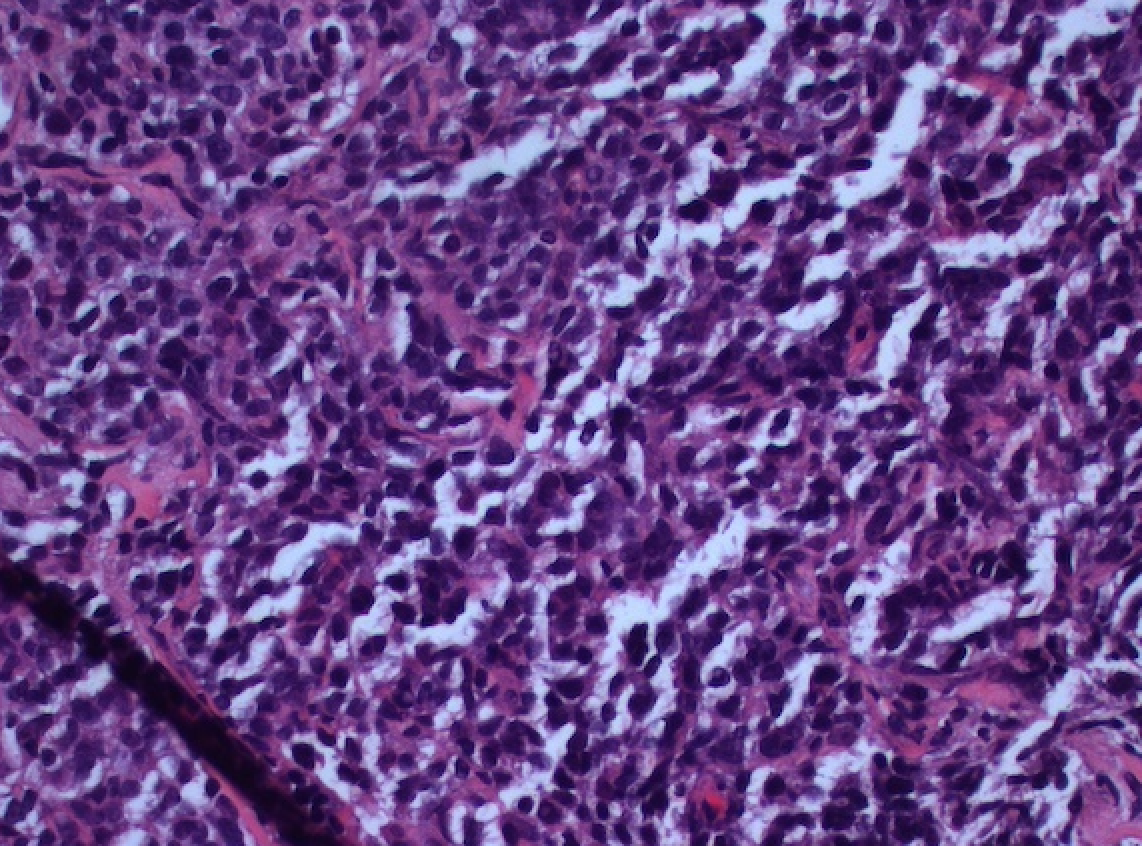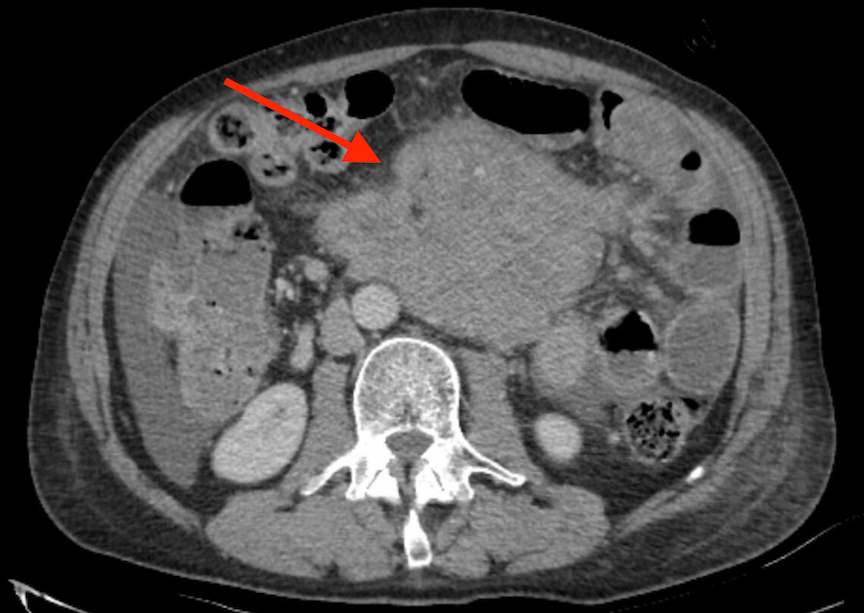Tuesday Poster Session
Category: Small Intestine
P6246 - Mesenteric Diffuse Large B-Cell Lymphoma: An Uncommon Cause of Small Bowel Obstruction
Tuesday, October 28, 2025
10:30 AM - 4:00 PM PDT
Location: Exhibit Hall
- MO
Matthew Orosa, DO
Riverside University Health System
Moreno Valley, California
Presenting Author(s)
Matthew Orosa, DO1, Mena Saad, DO1, Bing Wang, MD1, Andrew Chang, MD2
1Riverside University Health System, Moreno Valley, CA; 2Loma Linda University Medical Center, Loma Linda, CA
Introduction: Diffuse large B-cell lymphoma (DLBCL) is the most prevalent subtype of non-Hodgkin lymphoma globally. It is a rapidly growing and aggressive type of lymphoma, but has a high rate of response to therapy, making it highly curable for many patients. While DLBCL is the most common type of non-Hodgkin lymphoma, lymphoma involving the mesentery is uncommon and makes up about 1% to 3.6% of all gastrointestinal lymphomas. Furthermore, mesenteric DLBCL causing bowel obstruction is extremely rare, with very few cases reported in the literature. We present a case of a patient who initially presented with signs and symptoms of intestinal obstruction caused by mesenteric diffuse large B-cell lymphoma.
Case Description/
Methods: A 54-year-old male with substance use disorder presented with progressively worsening abdominal pain and distention over a period of one month. Three days before hospital admission, he developed vomiting and constipation. Physical exam revealed a distended and tender abdomen. CT scan was notable for a large mass involving the mesentery and small bowel dilatation, concerning for bowel obstruction. The patient underwent a biopsy of the mass. Results revealed a CD10+ diffuse large B-cell lymphoma with scattered residual dendritic meshwork, suggesting that the DLBCL transformed from a high-grade follicular lymphoma. Further testing revealed a proliferation rate > 90% by Ki67 staining. The final pathology report also showed positive BCL-2, BCL-6, and MUM-1. Given the patient’s bowel obstruction, chemotherapy (R-EPOCH) was initiated in the hospital per Oncology recommendations. The patient showed significant improvement with chemotherapy and began passing both stool and gas regularly and was discharged with outpatient follow up at the oncology clinic.
Discussion: Mesenteric diffuse large B-cell lymphoma associated with small bowel obstruction is an exceptionally rare occurrence. Most primary gastrointestinal lymphomas occur in the stomach (60-75%), followed by the small intestine (20-30%) and then the colon/rectum. In some cases, general surgery involvement may be necessary if complete intestinal obstruction is present. This case supports that early intervention can significantly enhance the chances of symptom relief and lead to a successful cure. Clinicians should remain aware in recognizing this rare cause of small bowel obstruction to avoid delays in diagnosis and treatment.

Figure: A large mass measuring 17 x 15 x 20 cm involving the mesentery of the mid-abdomen extending from the root of the mesentery to the pelvis.

Figure: Lymphoid tissue with diffuse lymphocytes effacing normal architecture.
Disclosures:
Matthew Orosa indicated no relevant financial relationships.
Mena Saad indicated no relevant financial relationships.
Bing Wang indicated no relevant financial relationships.
Andrew Chang indicated no relevant financial relationships.
Matthew Orosa, DO1, Mena Saad, DO1, Bing Wang, MD1, Andrew Chang, MD2. P6246 - Mesenteric Diffuse Large B-Cell Lymphoma: An Uncommon Cause of Small Bowel Obstruction, ACG 2025 Annual Scientific Meeting Abstracts. Phoenix, AZ: American College of Gastroenterology.
1Riverside University Health System, Moreno Valley, CA; 2Loma Linda University Medical Center, Loma Linda, CA
Introduction: Diffuse large B-cell lymphoma (DLBCL) is the most prevalent subtype of non-Hodgkin lymphoma globally. It is a rapidly growing and aggressive type of lymphoma, but has a high rate of response to therapy, making it highly curable for many patients. While DLBCL is the most common type of non-Hodgkin lymphoma, lymphoma involving the mesentery is uncommon and makes up about 1% to 3.6% of all gastrointestinal lymphomas. Furthermore, mesenteric DLBCL causing bowel obstruction is extremely rare, with very few cases reported in the literature. We present a case of a patient who initially presented with signs and symptoms of intestinal obstruction caused by mesenteric diffuse large B-cell lymphoma.
Case Description/
Methods: A 54-year-old male with substance use disorder presented with progressively worsening abdominal pain and distention over a period of one month. Three days before hospital admission, he developed vomiting and constipation. Physical exam revealed a distended and tender abdomen. CT scan was notable for a large mass involving the mesentery and small bowel dilatation, concerning for bowel obstruction. The patient underwent a biopsy of the mass. Results revealed a CD10+ diffuse large B-cell lymphoma with scattered residual dendritic meshwork, suggesting that the DLBCL transformed from a high-grade follicular lymphoma. Further testing revealed a proliferation rate > 90% by Ki67 staining. The final pathology report also showed positive BCL-2, BCL-6, and MUM-1. Given the patient’s bowel obstruction, chemotherapy (R-EPOCH) was initiated in the hospital per Oncology recommendations. The patient showed significant improvement with chemotherapy and began passing both stool and gas regularly and was discharged with outpatient follow up at the oncology clinic.
Discussion: Mesenteric diffuse large B-cell lymphoma associated with small bowel obstruction is an exceptionally rare occurrence. Most primary gastrointestinal lymphomas occur in the stomach (60-75%), followed by the small intestine (20-30%) and then the colon/rectum. In some cases, general surgery involvement may be necessary if complete intestinal obstruction is present. This case supports that early intervention can significantly enhance the chances of symptom relief and lead to a successful cure. Clinicians should remain aware in recognizing this rare cause of small bowel obstruction to avoid delays in diagnosis and treatment.

Figure: A large mass measuring 17 x 15 x 20 cm involving the mesentery of the mid-abdomen extending from the root of the mesentery to the pelvis.

Figure: Lymphoid tissue with diffuse lymphocytes effacing normal architecture.
Disclosures:
Matthew Orosa indicated no relevant financial relationships.
Mena Saad indicated no relevant financial relationships.
Bing Wang indicated no relevant financial relationships.
Andrew Chang indicated no relevant financial relationships.
Matthew Orosa, DO1, Mena Saad, DO1, Bing Wang, MD1, Andrew Chang, MD2. P6246 - Mesenteric Diffuse Large B-Cell Lymphoma: An Uncommon Cause of Small Bowel Obstruction, ACG 2025 Annual Scientific Meeting Abstracts. Phoenix, AZ: American College of Gastroenterology.
